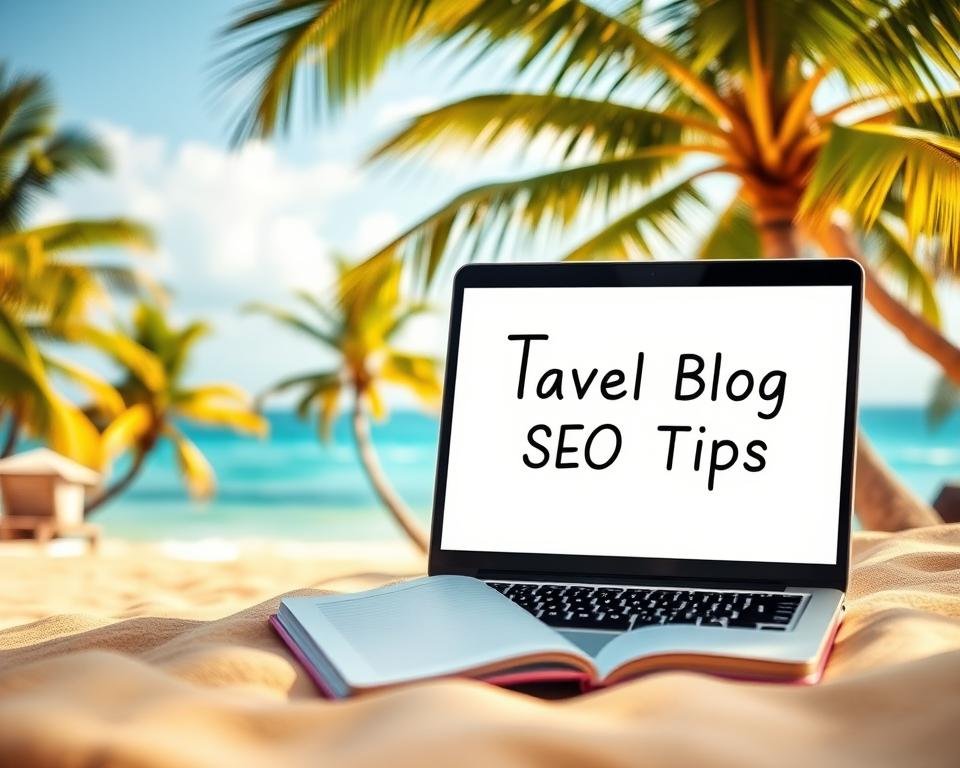I used to love traveling and now I blog about it. I found out that making my online content better is key to reaching more people. With so many bloggers out there, knowing effective SEO strategies is essential to be noticed.
Using the right methods can boost your site’s search rankings and bring in more visitors. In this article, I’ll share my best tips for ranking your travel posts. We’ll cover keyword research, on-page optimization, and more.
Key Takeaways
- Learn how to optimize your destination posts for better search engine rankings.
- Discover the importance of keyword research in Travel Blog SEO.
- Understand the role of on-page optimization in improving your website’s visibility.
- Get tips on how to create high-quality, engaging content that resonates with your audience.
- Find out how to measure and analyze your SEO performance.
Understanding the Basics of SEO for Travel Blogs
As a travel blogger, learning SEO basics can boost your online presence. First, you need to know what SEO is and why it’s key for travel bloggers.
What is SEO?
SEO means “Search Engine Optimization.” It’s about making your website more visible in search engines. You do this by using keyword research, on-page optimization, and link building.
By optimizing your blog, you can get more visitors. This is because your blog will show up higher in search results.
Why SEO Matters for Travel Blogging
SEO is important for travel bloggers because it helps you reach more people. It makes your blog more visible online. This means more visitors to your site.
Most travelers use search engines to plan their trips. A well-optimized blog can attract a lot of organic traffic. Plus, SEO is cheaper than paid ads, making it a must-have for bloggers.
Learning SEO can make your blog more visible. It brings in more traffic. This knowledge is the first step to more advanced SEO techniques.
Keyword Research for Travel Content
Keyword research is key to making travel content that people want to read. It helps you know what your audience is searching for. This way, you can make your blog more visible on search engines.
Tools for Effective Keyword Research
To find the right keywords, you need the best tools. Here are some top picks:
- Google Keyword Planner: A free tool that shows you keywords and how often they’re searched.
- Ahrefs: A big SEO tool that gives you insights on keywords, backlinks, and content.
- SEMrush: A tool for all your digital marketing needs, including keyword research and competitor analysis.
These tools help you find good keywords, see what your competitors are doing, and find ways to rank better.
| Tool | Primary Function | Cost |
|---|---|---|
| Google Keyword Planner | Keyword Research | Free |
| Ahrefs | SEO Analysis | Paid |
| SEMrush | Digital Marketing Analysis | Paid |
Identifying Long-Tail Keywords
Long-tail keywords are specific phrases with less competition and better conversion rates. For example, “budget travel tips for Europe” is better than “travel tips.” Use the tools above and look at what your audience searches for.
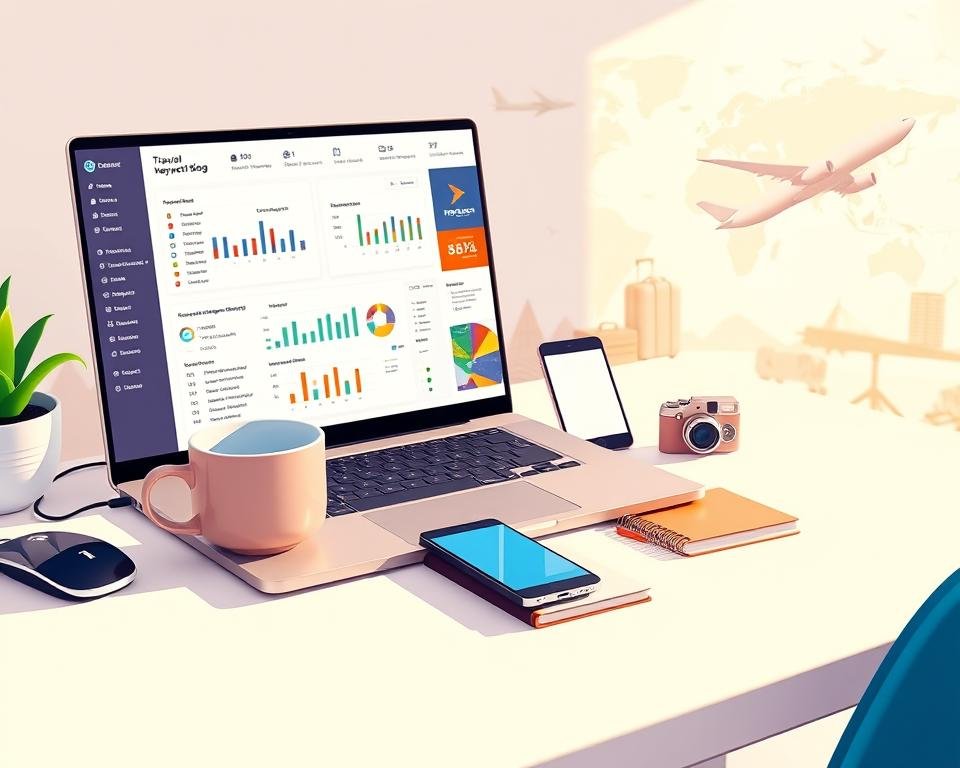
Using long-tail keywords can bring you a more focused audience. It also helps you rank higher in search results. This is great for travel blogs, as it lets you meet specific traveler needs.
On-Page SEO Techniques for Travel Posts
To boost your travel blog’s search rankings, learning on-page SEO is key. On-page SEO makes your web pages rank higher and get more relevant traffic. This part will cover the main on-page SEO tips to make your travel blog more visible.
Crafting SEO-Friendly Titles
The title of your blog post grabs the attention of search engines and readers first. Creating an SEO-friendly title means adding relevant keywords that match your post’s content. Choose a title that’s both informative and catchy to get more clicks.
For example, instead of “Travel to Paris,” pick “Discover the Charm of Paris: A Travel Guide.” This title includes the main keyword (“Paris”) and clearly shows what your post is about.
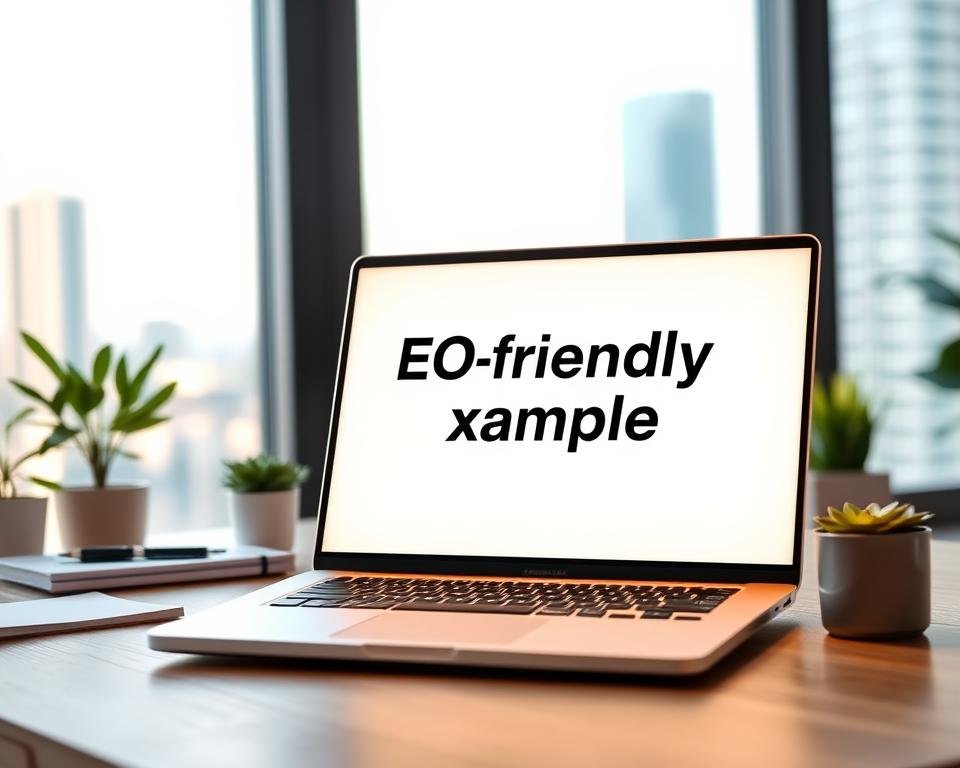
Writing Engaging Meta Descriptions
A meta description is a short summary of your blog post shown in search results. Writing a good meta description is key because it can make users click on your link. Put your primary keyword in the description and make it interesting and short.
A great meta description should make readers want to click on your link. For example, “Explore Paris’s top spots and secrets with our travel guide. Find the best places to visit, eat, and stay.”
Utilizing Header Tags Effectively
Header tags (H1, H2, H3, etc.) are important for organizing your content and making it easy to read. Use header tags to divide your content into sections and highlight important points.
| Header Tag | Purpose | Example |
|---|---|---|
| H1 | Main Title | On-Page SEO Techniques for Travel Posts |
| H2 | Subheadings | Crafting SEO-Friendly Titles |
| H3 | Sub-subheadings | Best Practices for Title Creation |
By using header tags well, you can make your travel blog posts easier to read and SEO-friendly. This helps search engines understand your page’s structure and content better.
Creating High-Quality Content
To stand out in the crowded travel blogging space, creating high-quality content is key. Good content attracts and keeps your audience. It also shows you know your stuff.
Travel blogging is all about unique content. It’s not just copying what others say. It’s about sharing new views and insights that others don’t.
The Importance of Unique Content
Unique content makes your blog stand out. By sharing travel blogging tips and real experiences, you gain loyal readers.
To be unique, share your own stories and lessons. Talk about local tips not in guidebooks or hidden spots.
Incorporating Local Insights and Tips
Adding local tips to your posts makes them more valuable. When I travel, I talk to locals and learn about their culture. I share these tips with my readers.
Some ways to add local insights include:
- Sharing local customs and traditions
- Highlighting authentic, locally-owned eateries and shops
- Providing tips on how to navigate local transportation
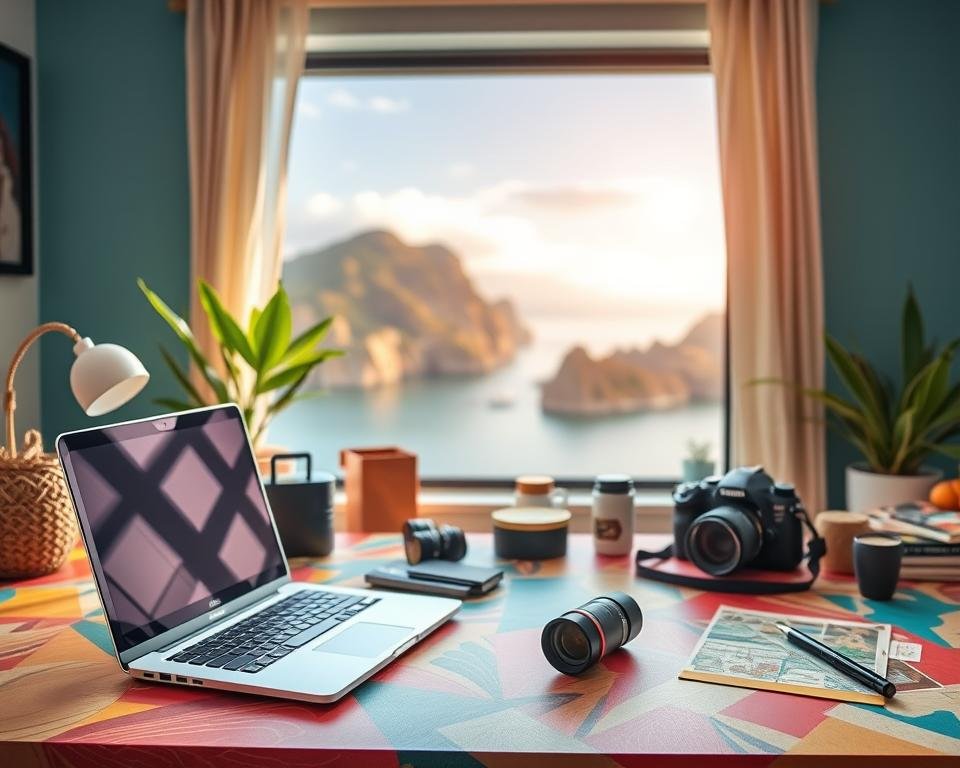
To make your travel blog better, think about how to optimize a travel blog for search engines. This means creating great content and making your blog easy to use.
Optimizing Images for SEO
As a travel blogger, you can make your website better by optimizing your images. This is key for SEO, making your site more visible and user-friendly.

There are important steps to take when optimizing images. One big one is to use clear filenames for your images.
Best Practices for Image Filenames
Good filenames help search engines get what your images are about. Don’t use names like “IMG_1234.jpg.” Instead, use names that include your keywords. For example, “eiffel-tower-paris-france.jpg” is better for a post about the Eiffel Tower.
Tips for creating effective image filenames:
- Use lowercase letters and hyphens to separate words.
- Include relevant keywords that describe the image.
- Avoid using special characters or numbers if possible.
Using Alt Text for Accessibility
Alt text is good for SEO and for people who can’t see images. It gives a description of the image. Make sure to include your keywords in the alt text.
Best practices for alt text:
- Be descriptive and concise.
- Include relevant keywords.
- Avoid keyword stuffing.
By following these tips, you can make your website faster, better for users, and higher in search rankings. This helps your travel content rank better in search engines.
Building Internal and External Links
As a travel blogger, knowing about internal and external linking is key. A good link profile boosts your site’s authority and brings more visitors.
Internal linking helps users find their way around your site. It also helps search engines see your site’s layout. By linking to related articles, you make your site easier to use and more engaging.
The Role of Internal Linking
Internal linking is important for SEO. It shows search engines your site’s layout. This can make your older posts more visible.
- Link to relevant articles to enhance user experience.
- Use descriptive anchor text to help search engines understand the content of the linked page.
- Avoid over-linking, as it can dilute the importance of your links.
How to Get Quality Backlinks
Getting quality backlinks boosts your site’s authority and search rankings. Here are ways to get them:
- Create high-quality, engaging content that other websites will want to link to.
- Reach out to other travel bloggers and influencers in your niche to collaborate and exchange links.
- Participate in guest blogging to build relationships and earn backlinks.
Here’s a comparison of different backlink strategies:
| Strategy | Effectiveness | Effort Required |
|---|---|---|
| Guest Blogging | High | Medium |
| Content Collaboration | High | High |
| Resource Pages | Medium | Low |

By using these strategies and building a strong link profile, you can improve your search rankings for your travel blog. This will bring more visitors to your site.
The Power of Local SEO
Travel bloggers can boost their site’s traffic by focusing on local SEO. It’s key for those who write about specific places or attractions.
Local SEO helps target specific search queries. For example, a blogger about Colorado hiking can use “best hiking trails in Colorado” or “Colorado hiking trails for beginners.”
Strategies for Optimizing Local Searches
To improve local search rankings, bloggers should list their site in local directories. This includes Google My Business and Bing Places.
- Use location-specific keywords in your content, meta tags, and titles.
- Create content that is relevant to local search queries, such as guides to local attractions or events.
- Optimize your website for mobile devices, as many local searches are conducted on smartphones.
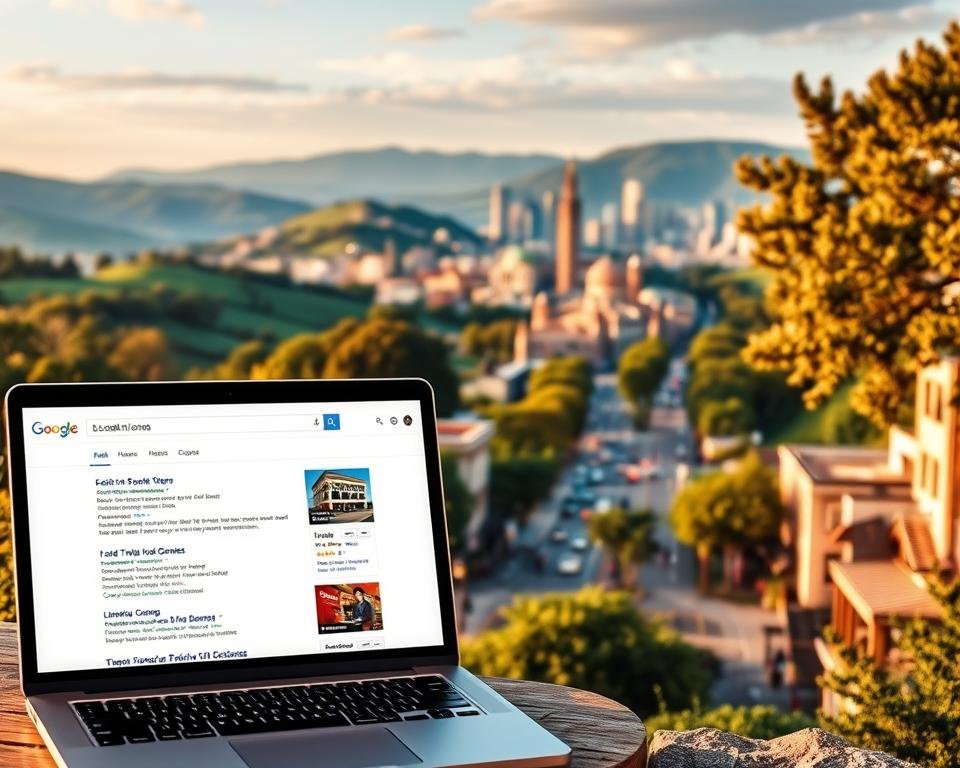
Leveraging Google My Business
Google My Business is a great tool for local SEO. Claiming and optimizing your listing can boost your local search visibility.
| Google My Business Feature | Description | Benefit |
|---|---|---|
| Accurate Business Hours | Ensure your business hours are up-to-date | Helps locals find you when you’re open |
| High-Quality Photos | Add photos of your business, products, or services | Enhances your listing and attracts more views |
| Customer Reviews | Encourage customers to leave reviews on your listing | Improves credibility and local search rankings |
By using these local SEO strategies and Google My Business, bloggers can get more local traffic to their site.
Utilizing Social Media for Visibility
In today’s world, social media is key for travel bloggers to grow. You can boost your online presence with smart social media use.
Sharing Content on Relevant Platforms
It’s important to post on sites where your audience hangs out. For travel bloggers, Instagram and Pinterest are great choices.
- Instagram: Share top-notch photos and stories from your travels. Use hashtags to get more views.
- Pinterest: Make boards for places or travel ideas. Pin your posts to attract trip planners.
Posting on these sites can send more visitors to your blog and help your search rankings.

Engaging with Your Audience
On social media, it’s not just about posting. It’s also about talking back to your followers. Reply to comments, ask for opinions, and chat with other travel bloggers.
| Engagement Strategy | Description | Benefit |
|---|---|---|
| Responding to Comments | Reply to comments on your social media posts | Builds a loyal community |
| Asking for Feedback | Encourage followers to share their travel experiences | Provides valuable insights |
| Engaging with Other Bloggers | Interact with fellow travel bloggers on social media | Expands your network |
By talking to your audience, you can create a dedicated group. They’ll support your blog and share your work.
Analyzing and Measuring Performance
Measuring your SEO success is key for your travel blog’s growth. You must analyze and measure your performance often.
Tools for Tracking SEO Performance
Many tools can track your SEO performance well. Google Analytics gives deep insights into your site’s traffic and how users engage. It also shows your conversion rates.
Google Search Console helps monitor your keyword rankings and how often people see your site. Tools like Ahrefs and SEMrush do SEO audits and track keywords. They help spot areas to improve and see how your SEO works.
Understanding Key Metrics
To really get into your SEO performance, you need to know about key metrics. Keyword rankings show how well your content matches search terms. Organic traffic tells you how many visitors find your site through search engines.
Bounce rates and average session duration tell you about user interest. A high bounce rate might mean your content doesn’t match what people want. But a longer session time means visitors find your content useful.
By knowing these metrics and using the right tools, you can make your SEO better. This will help your travel blog be more visible and successful.
Keeping Up with SEO Trends
To keep your travel blog ahead, it’s key to follow the latest SEO trends. Search engine rules and how people use them change often. Travel bloggers must keep up and adjust their plans to stay on top.
Staying Informed About Algorithm Changes
Google and other search engines update their rules often. These changes can really affect how visible your blog is. It’s important to know about these updates to keep your blog’s ranking high.
- Follow trusted SEO news sites and blogs for updates.
- Join online groups and forums where SEO experts share tips.
- Go to webinars and conferences on SEO to learn from the best.
Holiday and Seasonal SEO Strategies
Using holiday and seasonal trends can really help your blog get more visitors. By adding seasonal keywords and content, you can draw in people looking for travel info at the right time.
Key Strategies for Seasonal SEO:
- Plan your content for big holidays and seasons.
- Use seasonal keywords in your titles and descriptions.
- Make content that fits the current season or holiday.
| Season/Holiday | Keyword Opportunities | Content Ideas |
|---|---|---|
| Summer Vacation | Beach destinations, summer activities | Top 10 beach resorts, summer hiking trails |
| Christmas | Holiday markets, festive destinations | Christmas markets in Europe, festive getaway ideas |
| New Year | New Year’s Eve destinations, resolutions travel | Top destinations for New Year’s Eve, New Year’s resolutions travel guides |
By keeping up with algorithm changes and using holiday and seasonal SEO, you can make your travel blog more visible. This will help attract more visitors who are interested in what you offer.
Conclusion: Putting It All Together
As we finish our look at Travel Blog SEO, it’s clear that many strategies are needed. Understanding SEO basics, doing deep keyword research, and making great content are key. These steps can really help your travel blog show up more online.
Key Takeaways for Success
To get better search rankings, make your titles SEO-friendly. Use header tags well and optimize your images. Also, build links, use local SEO, and be active on social media. These steps can bring more visitors to your site.
Start Implementing Travel Blogging Tips Today
Using these tips, you can make a travel blog that draws in and keeps your audience. Start using these strategies to get more seen online. This will help more people visit your site, making your Travel Blog SEO better.
